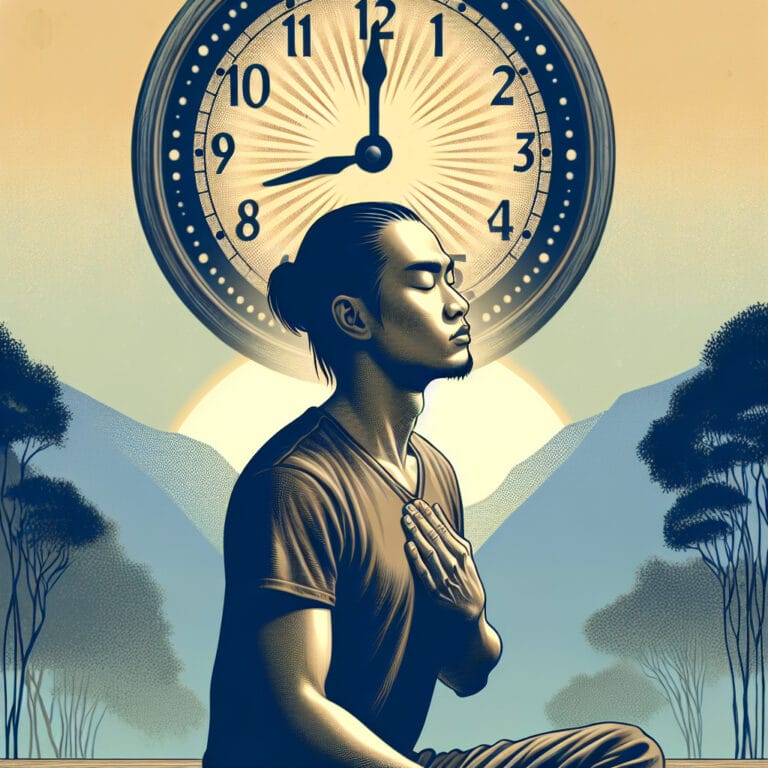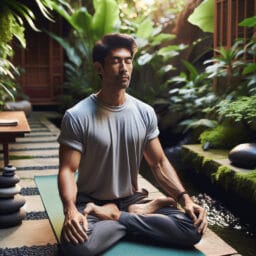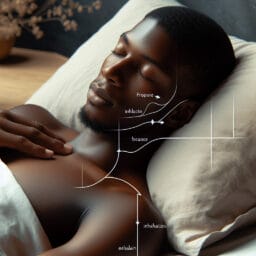
Fall Asleep Faster: Mastering the 4-7-8 Breathing Technique for Quick Sleep Onset
Table of Contents
- Introduction
- What is the 4-7-8 Breathing Technique?
- Benefits of the 4-7-8 Breathing Technique for Sleep
- How to Incorporate the 4-7-8 Technique into Your Nightly Routine
- Tips for Mastering the 4-7-8 Breathing Technique
- Advanced Strategies for Better Sleep
- Conclusion
- Frequently Asked Questions
Introduction
Dr. Andrew Weil, a Harvard-trained medical doctor with a focus on holistic health, advocates for the ancient yogic practice of 4-7-8 breathing as a calming exercise with powerful implications for sleep enhancement. This breathing exercise embodies the quintessence of diaphragmatic breathing and has its ancient roots in pranayama—a vital part of yoga known for promoting relaxation and stress reduction. By following this simple pattern—inhaling quietly through the nose for four counts, holding the breath for seven counts, exhaling with a whoosh sound for eight counts—individuals can engage their parasympathetic nervous system, which serves to counteract the body’s fight-or-flight response often triggered by daily stresses.
Embracing slow breathing techniques like the 4-7-8 method before bedtime is shown to have health benefits that extend beyond merely falling asleep faster. It enables deep relaxation responses within your body and sets up an ideal environment conducive to restful sleep. When practiced consistently, it not only helps reduce anxiety but also assists in treating anxiety-related sleeping disorders by grounding one’s nervous system and reducing stress hormones.
Moreover, this relaxation exercise underscores how controlled breathwork like box breathing or other variations can significantly alter our physiological state—transitioning from sympathetic nervous system dominance (which stimulates alertness) to a more tranquil state aligned with sleep readiness through activation of the parasympathetic nervous system. While engaging in these deep breathing exercises such as 4-7-8 technique may induce feelings of lightheadedness initially due to increased oxygen intake, regular practice leads to mastery over one’s respiratory patterns thereby enhancing overall well-being.
Incorporating this mindful deep breath routine into your nightly regimen can transform your experience of sliding into sleep; rather than tossing and turning while mentally recounting worries or tasks ahead, you create an intentional pathway toward tranquility—a valuable asset amidst our fast-paced modern life that often overlooks the importance of nurturing restorative rest cycles grounded in time-tested practices like this transformative breathing technique.
What is the 4-7-8 Breathing Technique?
Dr. Andrew Weil’s pioneering work on the 4-7-8 breathing exercise illuminates a path to tranquility harkening back to ancient yogic practices, thus providing a bridge from past wisdom to modern wellness routines. This deep breathing technique is based on pranayama, an Indian system that precisely calibrates breath for the harmonization of body and mind—something our ancestors knew well and which now garners empirical support through contemporary research. The practice involves breathing in quietly through the nose for four counts, holding your breath comfortably—for seven counts—which requires diaphragmatic breathing control, then exhaling with a distinctive whoosh sound for eight counts. It’s a simple yet powerful grounding exercise that anyone can perform from a comfortable position before sleep.
Delving deeper into this relaxation response inducer, here’s how you can seamlessly weave the 4-7-8 technique into your nightly routine: First, find a comfortable position in bed or sitting up—ensure your posture doesn’t impede abdominal movement. Close your eyes gently to prepare for reducing stress and focus on your natural breath rhythm before starting. Then follow the count sequence: inhale softly but deeply through the nose for four seconds; hold this inhalation steadying yourself with calmness during seven seconds; finally release tension emitting an audible whoosh sound as you slowly breathe out completely over eight seconds. This cycle should be repeated three to four times initially, gradually increasing repetitions as comfort with the practice develops.
Engaging consistently in such slow breathing has been shown scientifically to influence both branches of our autonomic nervous system—the parasympathetic (promoting rest) and sympathetic (activating fight-or-flight responses). By deliberately extending exhalation longer than inhalation and adding the counts holding phase, we are inviting our nervous system to shift towards parasympathetic dominance—the state conducive to falling asleep naturally.
Additionally, box breathing and similar techniques pale when compared against specific health benefits associated with this focused form of anxiety reduction; it actively lowers heart rate while enhancing oxygen saturation—a boon not only for those seeking relief from day-to-day tensions but also vital in treating anxiety-related sleep disorders by fostering an optimal environment conducive to fall asleep faster.
To fully harness these benefits though involves more than just occasional practice—it requires establishing it as part of one’s evening ritual which means consistency is key alongside gradual build-up in repetition count tailored towards individual comfort levels without inducing feelings like lightheadedness caused by increased oxygen intake initially encountered by novices.
In summing up its profound impact beyond mere anecdote or philosophy—scientific scrutiny validates what might appear as just another relaxation exercise; it effectively bends our biochemistry towards serenity making 4-7-8 not only an act of ancient yogic tradition but also a validated tool for health enhancement within reach today-Clause 5-Clause 6-Clause 1-Clause 2-Clause 3-Clause .
| Aspect | Details |
|---|---|
| Origin | Based on pranayama, an ancient yogic practice |
| Pioneer | Dr. Andrew Weil |
| Purpose | Stress reduction, tranquility, improved sleep |
| Method |
|
| Initial Repetitions | 3 to 4 cycles |
| Position | Comfortable, allows for abdominal movement |
| Autonomic Nervous System Impact | Parasympathetic activation, sympathetic modulation |
| Health Benefits | Lower heart rate, higher oxygen saturation, aids in anxiety-related sleep disorders |
| Practice Frequency | Daily, as part of evening ritual |
| Safety Note | Avoid feelings of lightheadedness; adapt slowly |
| Scientific Validation | Empirical support for health enhancement |
Benefits of the 4-7-8 Breathing Technique for Sleep
The transformative power of the 4-7-8 breathing technique for sleep, championed by Dr. Andrew Weil, lies in its unique ability to prompt the relaxation response within the nervous system—a key to unlocking restorative slumber. This ancient yogic practice has been modernized to serve as a beacon for those navigating the turbulent waters of stress and insomnia. By inducing a rhythm that asserts control over the often erratic fight-or-flight response, this methodical breathing exercise cultivates an inner sanctuary conducive to falling asleep with ease.
Embarking on this nightly voyage begins with finding a comfortable position that frees diaphragmatic movement, essential for deep breathing. As one inhales quietly through the nose for four counts and transitions into seven counts holding their breath, they invite calmness to pervade their being. The subsequent eight-count exhalation carries away tension with its resonant whoosh sound—a signature auditory cue that complements slow breathing’s physiological benefits.
Aside from aiding in swiftly transitioning into sleep’s embrace, regular engagement with this grounding exercise unveils additional health benefits woven into its disciplined cadence. It serves as an invaluable tool in reducing anxiety by recalibrating our sympathetic nervous system’s overactive stress response while nurturing our parasympathetic nervous system—the cornerstone of relaxation and digestion—to take charge. With each deliberate cycle of breaths—inhale, counts hold, exhale—we construct a bulwark against daily anxieties and fortify our mental resilience.
Moreover, incorporating 4-7-8 breathing exercises into your nightly repertoire doesn’t merely reduce anxiety; it fosters an elevated state of well-being where stress dissolves upon engaging in these purposeful inhalations and exhalations—each breath carving out pathways toward tranquility like water shapes stone over millennia. In harnessing such profound effects rooted in ancient wisdom yet backed by science, we glean not just improved quality of sleep but also enhanced oxygen saturation and heart rate moderation—hallmarks of sound health ingrained within this simple yet potent relaxation exercise.
In committing to this calming ritual before bed each night—away from the day’s cacophony—one can expect not only serene descent into dreams but also emerge revitalized come dawn due to deepened quality rest achieved through this meditative practice—an ode to timeless traditions now accessible amid contemporary lifestyles seeking solace within each mindful deep breath taken.
How to Incorporate the 4-7-8 Technique into Your Nightly Routine
Harnessing the full potential of the 4-7-8 breathing technique for sleep involves more than mere practice; it’s a symphony where each element, from your sleep environment to complementary sleep hygiene practices, plays a critical part in orchestrating a night of restful slumber. Dr. Andrew Weil’s ancient yogic practice, deeply rooted in diaphragmatic breathing and mindful exhales with a calming whoosh sound, offers profound health benefits by engaging the parasympathetic nervous system—our innate relaxation response facilitator. To amplify this effect and reduce anxiety for improved sleep quality, consider crafting a serene ambiance: dim lighting or blackout curtains can signal your sympathetic nervous system that it’s time to power down, while soothing sounds or silence set an acoustic stage conducive to deep breathing exercises.
Pairing the rhythmic grounding exercise of 4-7-8 with established sleep hygiene habits like maintaining a regular bedtime schedule further aligns your internal clock towards falling asleep naturally. A comfortable position in bed free from distractions allows you to focus on reducing stress through each inhale and counts hold—a beneficial contrast to our daytime fight-or-flight response. Moreover, integrating slow breathing techniques such as box breathing during downtime can help sustain reduced anxiety levels throughout your day, culminating in an easier transition into nighttime relaxation exercises.
Yet beyond just preparing the physical setting and combining other positive bedtime rituals is recognizing that reducing anxiety via ancient roots such as these controlled breathwork patterns is not merely about treating anxiety-related sleeping disorders—it’s also about embracing lifestyle changes that foster holistic well-being. Regularly engaging in this relaxation exercise before bed extends beyond simply avoiding feeling lightheaded; it enriches oxygen saturation levels and instills tranquility across our entire being.
Incorporating these insights into your nightly routine may reshape how you view bedtime: no longer just an end but rather a rejuvenating pause—a sacred interval wherein each deep breath becomes both healing balm for today’s stresses and preparation for tomorrow’s endeavors. Through consistent dedication to this transformative breathing exercise combined with thoughtful sleep protocols, you invite restorative rest—one night at a time—into your life’s rhythm.
Tips for Mastering the 4-7-8 Breathing Technique
Amid the myriad of breathing techniques designed to usher in peaceful slumber, the 4-7-8 breathing exercise stands out for its simplicity and efficacy. Dr. Andrew Weil’s modern take on this ancient yogic practice harnesses the innate power of diaphragmatic breathing to activate the parasympathetic nervous system—the body’s tranquil haven away from the hyper-alertness triggered by our sympathetic nervous system’s fight-or-flight response. When practiced consistently, this grounding exercise has shown remarkable health benefits, notably anxiety reduction and fostering a relaxation response conducive for falling asleep.
Many beginners find their initial attempts at this breathing technique challenged by distractions or discomfort in maintaining counts hold. A key solution is establishing a comfortable position free from interruptions—a quiet environment where one can focus solely on their breath without succumbing to habitual stressors that might trigger a stress response. Consistency is crucial; therefore, initiating this relaxation exercise as part of your pre-sleep ritual can vastly improve its effectiveness.
Timing can elevate the success rate of adopting any new habit—especially those involving reducing anxiety through controlled breathwork patterns such as box breathing or deep breathing exercises like 4-7-8. Integrating this technique into your routine approximately 30 minutes before sleep primes your nervous system for rest, yet it’s versatile enough to be applied anytime you feel overwhelmed during the day or when you need a momentary retreat from life’s frenetic pace.
Unlike other slow breathing methods that may induce dizziness or feeling lightheaded in novices due to prolonged exhalation phases, starting with shorter cycles and gradually increasing duration helps mitigate such effects while accruing profound relaxation benefits over time. With each inhalation, envision drawing calmness into every cell; with every exhaled whoosh sound, expel lingering tensions—transforming what begins as mere breath control into an enriching experience rooted in ancient wisdom yet tailored for contemporary wellbeing.
Ultimately, embracing the 4-7-8 rhythm isn’t just about mastering a new way to breathe—it’s about reclaiming stillness amidst chaos and aligning oneself with healthier sleep patterns invigorated by deep breaths’ therapeutic cadence—an invaluable asset in today’s fast-paced existence.
Advanced Strategies for Better Sleep
Adapting the 4-7-8 breathing technique to one’s personal sleep routine offers a customizable approach to unlocking the profound relaxation response of our parasympathetic nervous system. Popularized by Dr. Andrew Weil, this ancient yogic practice has found its place as a cornerstone in modern relaxation exercises, offering an antidote to the hyper-aroused state induced by our sympathetic nervous system’s fight-or-flight response. When seamlessly integrated with other breathing exercises such as box breathing, individuals report an enhanced ability to fall asleep faster and experience deeper rest throughout the night. The inherent beauty of this grounding exercise lies in its simplicity: a delicate balance of deep breathing, counts holding, and that therapeutic whoosh sound which not only aids in reducing anxiety but also confers additional health benefits.
Individuals can tailor this breathing exercise to suit their unique rhythms—whether they require longer periods of counts hold for anxiety reduction or prefer shorter cycles when they begin to feel lightheaded. This flexibility empowers users to engage with their breath at a level that feels both comfortable and effective for them personally. Far from being static, adapting the duration of diaphragmatic breathing or modifying the intensity of exhalation allows each person to find their optimal pathway to tranquility.
To further enrich sleep quality alongside 4-7-8’s slow breathing cadence, incorporating practices such as progressive muscle relaxation or guided meditation before bedtime can create a synergistic effect conducive for falling asleep. These techniques work in concert with deep breaths taken during the 4-7-8 method—each reinforcing the other’s ability to usher calmness into every fiber of one’s being.
Moreover, acknowledging contemporary research validating these ancient roots underscores how embracing a holistic strategy—melding purposeful respiration patterns with lifestyle modifications—is key for treating anxiety-related sleeping disorders effectively. By establishing these practices as non-negotiable elements within one’s nightly routine, people often discover they not only reduce stress but also foster consistent sleep hygiene that promotes overall vitality and wellness.
In essence, mastering the artistry involved in personalized 4-7-8 rhythmic respirations opens up new avenues for achieving peaceful slumber—a testament not just to Dr. Andrew Weil’s contributions but also humanity’s ongoing search for natural remedies grounded in time-honored wisdom yet illuminated by current-day science on enhancing life through conscious breath control.
| Strategy | Description | Benefits |
|---|---|---|
| 4-7-8 Breathing Technique | Deep breathing pattern popularized by Dr. Andrew Weil that helps trigger the parasympathetic nervous system to induce relaxation. | Reduces anxiety, enhances ability to fall asleep, and promotes deeper sleep. |
| Box Breathing | Integrating with other breathing exercises like box breathing for better efficacy. | Improves concentration and emotional regulation, complements the 4-7-8 technique. |
| Customization | Adjusting the duration and intensity of breaths to fit personal comfort levels and needs. | Empowers user to find an optimal balance for relaxation and anxiety reduction. |
| Progressive Muscle Relaxation | Technique involving the tensing and then relaxing of muscle groups in a particular order. | Reduces physical tension and stress, leading to better sleep quality. |
| Guided Meditation | Using visualization or verbal instruction to guide thoughts towards a calm state. | Facilitates mental relaxation and can enhance the effect of breathing exercises. |
| Lifestyle Modifications | Incorporating habits like avoiding caffeine before bed and maintaining a consistent sleep schedule. | Improves overall sleep hygiene and can alleviate anxiety-related sleeping disorders. |
| Holistic Strategy | Combining purposeful respiration with lifestyle changes for a comprehensive approach to sleep improvement. | Leads to better stress management, sleep quality, and overall vitality. |
| Scientific Validation | Contemporary research supporting ancient practices like the 4-7-8 breathing technique. | Confirms effectiveness and encourages a natural approach to managing sleep and anxiety. |
Conclusion
Harnessing the power of controlled respiration, Dr. Andrew Weil’s 4-7-8 breathing technique has emerged as a revered beacon in the quest for better sleep and anxiety reduction, deeply rooted in the wisdom of ancient yogic practices. This particular breathing exercise transcends mere nighttime routine, offering a holistic approach to engaging the parasympathetic nervous system and quelling the overactive fight-or-flight response governed by its sympathetic counterpart. By adopting a comfortable position and partaking in this practice—where one inhales for four counts, holds that breath with intention during seven counts, before releasing it with a therapeutic whoosh sound across eight counts—not only does one stand to fall asleep faster but also reaps cumulative health benefits including enhanced relaxation response and stress mitigation.
What distinguishes this grounding exercise from other deep breathing exercises is its deliberate pacing which encourages slow breathing that effectively reduces anxiety levels while preparing the body for restful slumber. As you engage in diaphragmatic breathing through this method, each deep breath serves as an anchor, grounding your thoughts away from daily stresses and fostering an environment conducive for falling asleep. The practice’s simplicity masks its profound impact; regular incorporation of these calming breaths into your bedtime ritual can profoundly transform sleep quality—a testament to its efficacy beyond box breathing or alternative relaxation techniques.
Akin to exploring ancient roots within our modern existence, practitioners often experience an invigorating sense of clarity post-session—a direct result of reduced stress response due to consistent practice. While some may initially feel lightheaded during counts holding phases due to increased oxygen intake, such sensations typically subside with patience and perseverance in mastering the technique’s nuances. For those treating anxiety-related sleeping disorders or simply seeking tranquility after hectic days, incorporating this potent relaxation exercise into daily routines promises not just immediate relief but also long-term serenity—an essential component of holistic health underscored by deep breaths taken mindfully before bed each evening.



